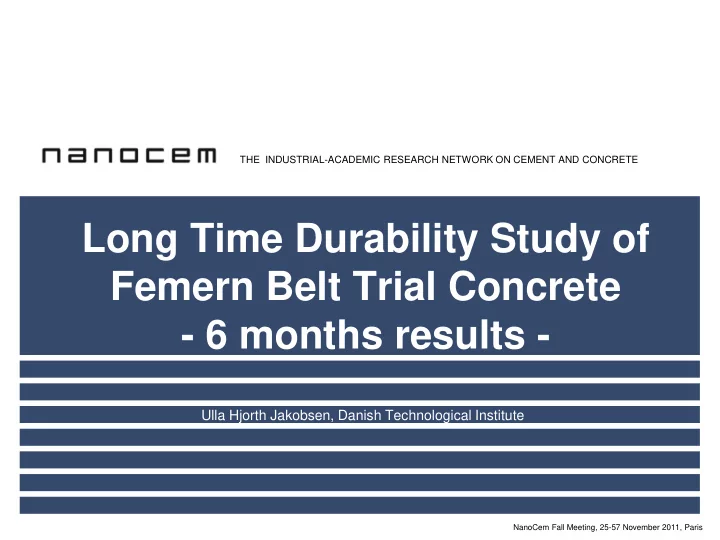

THE INDUSTRIAL-ACADEMIC RESEARCH NETWORK ON CEMENT AND CONCRETE Long Time Durability Study of Femern Belt Trial Concrete - 6 months results - Ulla Hjorth Jakobsen, Danish Technological Institute NanoCem Fall Meeting, 25-57 November 2011, Paris
Contents Introduction Analysis Program 6 Months Results - Microstructural appearances - Sulfate, magnesium and chloride ingress NanoCem Fall Meeting, 25-57 November 2011, Paris
Introduction/Background In 2009 Denmark and Germany agreed about building a physical connection between the 2 countries, the Femern Belt Fixed Link 20km long connection Planed to finish in 2019 18 trial concretes have been cast for a long time durability study of concrete subjected to seawater Testing periods: 28days, 6 The purpose of this presentation is to months, 2 years, 5 years, 8 years present the microscopic appearances of the concretes after 6 months of submersion in seawater.
Binder Combinations of Trial Concrete A Portland low alkali sulfate resistant cement (CEM I 42,5 N) w/c=0.40. B CEM I 42,5 N with 15% fly ash, w/c=0.40. C CEM I 42,5 N with 25% fly ash, w/c=0.40. D CEM I 42,5 N with 25% fly ash, SCC, w/c=0.40. E CEM I 42,5 N with 4% silica fume, w/c=0.40. F CEM I 42,5 N with 12% fly ash and 4% silica fume, w/c=0.40. G CEM I 42,5 N with 12% fly ash and 4% silica fume, no air entrainment, w/c=0.40. H CEM I 42,5 N with 12% fly ash and 4% silica fume, w/c=0.45. I CEM I 42,5 N with 12% fly ash and 4% silica fume, w/c=0.35. J CEM I 42,5 N with 12% fly ash and 4% silica fume, SCC, w/c=0.40. K Traditional slag cement (CEM III/B), w/c=0.40. L CEM III/B, no air entrainment, w/c=0.40. M CEM III/B, SCC, w/c=0.40. N 70 % slag mixed with 30% rapid cement (CEM I 52,5 N) w/c=0.40. O CEM I 42,5 N with 4% silica fume with super absorbing polymers, w/c=0.40. Basis cement (CEM II, 52.5 – containing <5% LF and FA) Rapid hardening cement (CEM I 52.5 LA/MS) Rapid hardening cement (CEM I 52.5 LA/MS) with 30% fly ash
Laboratory Testing, Casting, Coring … Fresh concrete properties Microscopy Casting October 2009 6 months exposure October 2011 Next coring period: April 2012 28 days maturity testing Exposure site in Rødby Harbor April 2010
Microscopic Analysis Program Macro-analysis: Crack pattern, homogeneity… Micro-analysis - OPM: Paste porosity, leaching, carbonation, precipitates, micro- cracks … SEM-EDX: Structural 45 mm analysis, chemical trends, phase identification, phase analysis … Depth: 0,7mm Depth: 23mm Depth: 0,3mm
Surface Alteration D: CEM I SR, 25% FA, SCC E: CEM I SR, 4% SF A: CEM I SR B: CEM I SR, 15% FA K: CEM III Basis: CEM II J: CEM I SR, 12% FA, 4% SF, SCC Basis: Gypsum in void All surfaces show after 6 months submersion in seawater sign of water ingress in the form of Max depth of altered surface, mm alternating porous, cracked, dense and leached zones. A B D E J K CEMII 2 3 2 2.5 2.5 0.8 1
Carbonation A: CEM I SR B: CEM I SR, 15% FA D: CEM I SR, 25% FA, SCC E: CEM I SR, 4% SF K: CEM III Basis: CEM II J: CEM I SR, 12% FA, 4% SF, SCC • Most concrete are carbonated in the surface. • A black zone, leached in CH appears behind carbonated surface. • Surfaces are partly intact, covered by calcite crust, or scaled. Max. depth of surface carbonation, mm J: Gypsum in air voids A B D E J K CEMII 0.3 <0.1 0.2 0.4 0.2 0.8 1.0
Porosity A: 0.40 28dg A: 0.40 6mdr B: 15% FA, 0.40 28dg B: 15% FA, 0.40 6mdr D: 25% FA, 0.40, SCC 28dg D: 25% FA, 0.40, SCC 6mdr E: 4% MS, 0,40 28dg E: 4% MS, 0,40 6mdr K: Slag cement, 0.40 28dg K: Slag cement, 0.40 6mdr J: 4% MS, 12% FA, SCC 28dg J: 4% MS, 12% FA, SCC 6mdr Generally the paste becomes denser with time Increased surface porosity appears in most concrete Porosity of CEM II does apparently not change with time Basis: CEMII 28dg Basis: CEMII 6mdr
CEM I SR, 12% FA, 4% SF, SCC, 6 months exposure Severe Cracking! Ca/Mg distribution 28 days Densification 6 months
CEM III/B, 6 months exposure Ca/Mg distribution Initial high porosity ? 28 days Densification 6 months
Chemical trends as a function of Binder Systems Concrete Binder Mg zone S zone Cl zone A CEM I 0-0.3 0.2-2 0.4-20 B CEM I, 15%FA 0-0.4 0.3-1 0.6-15 D CEM I, 25% FA 0-0.3 0.2-2 0.8-12.5 E CEM I, 4% SF 0-0.2 0.2-2 0.4-12.5 J CEM I, 12%FA, 4%SF 0-0.7 0.7-3 2-12.5 K CEM III 0-0.4 0.4-1 0.7-5 Basis CEM II 0-0.3 0.1-1 0.5-15
Phase Analysis: Sulfate phases in Concrete J
Phase Analysis: Magnesium phases Cracking! Severe cracking! Cracking!
Phase Analysis: Chloride phases Chloride tends to bound into Friedel’s salt in pockets Do chlorides bound in inner hydration phases with time?
Summary All concrete shows alteration in the surface region Surface porosity has changed in all concretes except in CEM II concrete A distinct chemical zoning of the concrete surfaces has been observed The concrete showing the Altered - zoned Apperantly unaltered most distinct surface alteration C De-calcified C De-calc Normal hydrated paste is concrete with silica fume & Dense Porous Denser than 28 days fly ash Whats Next Coring April 2012, 2 years of exposure Consolidation of 6 months data Casting of concrete, cured at 10, 20, 30, 45 & 60 oC
THE INDUSTRIAL-ACADEMIC RESEARCH NETWORK ON CEMENT AND CONCRETE
Recommend
More recommend